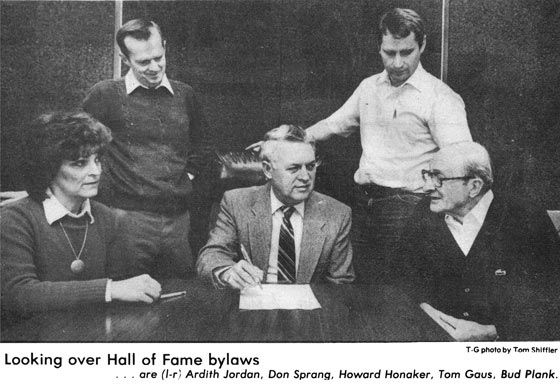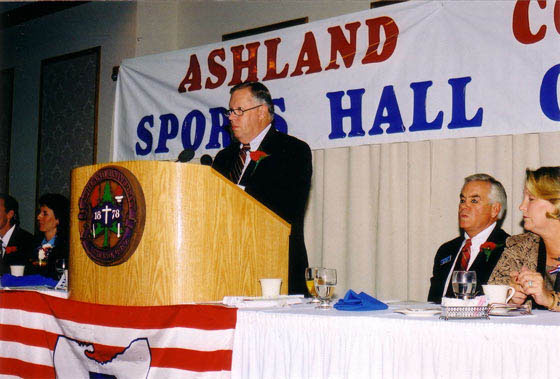Hall of Fame History
The “Father of the Ashland County Sports Hall of Fame” is Bill Mills. He was inducted into the HOF in 1998 after thousands of hours of legwork and his enthusiastic vision for the organization. The HOF was a crowning achievement to his career as a promoter and a fundraiser for teams, leagues, ball fields countywide and even the lights at Myers Field.
In a recent interview when he was asked,” Did you think a long time about starting the Hall of Fame?” He replied, “No! I heard Ed Arn on Wooster radio talking about their Hall of Fame induction (1982), and I immediately started thinking that we should do that in Ashland County.” He contacted Ed Arn and took Bud Plank and Bob Hamilton to Wooster for a nine o’clock meeting that lasted into the afternoon on ‘how they ran the Wayne County HOF.”
Bill’s first recruit, Bud Plank, proved to be a gem, as a tireless worker for the HOF and a profound source of historical knowledge of especially the old-time greats from Ashland County. It was said that of the first several groups of nominees Bud knew every one of them.
Bill’s position as a salesman at Strauss and Son Clothing served as a lightning rod to spark the growth of the organization. Almost daily on his lunch break he would rush over to Hale Avenue to report to Bud and Betty Plank about his most recent draftee and say, “He wants to get involved.” Betty recalled, “Everyday I would ask if he’d had lunch and did he want a sandwich?” Then they would mull over the possibilities of an Ashland County Hall of Fame. The Planks even chuckled over Bill’s exuberance that after seeing the Pro Football Hall of Fame, he looked into the cost of buying blazers for the Ashland HOF inductees.
As the likeable “Buster” Mills recalled the formative days of his HOF crusade, he would remember name after name and say, “that Dave Gray, he’s a good man, and Tom Gaus, and Bob Jones, and Don Sprang. There were so many good people.” Even Tom Gaus, the First Vice President used the same words, “There was so many good people from all parts of the county. It was an enjoyable time with them.” But as Bill pondered the beginnings, he said, “The first person I approached for money was Howard Honaker at Faultless Rubber. I knew he was sports minded and a good supporter of community projects.” It proved to be a great choice as Howard served as HOF President for the first three classes and his Faultless meeting room became the headquarters for launching the group.
Howard reminisced, “Bill hounded me for about a year to get it started. He was good at that and I don’t think he wanted to head it up. The first six months we met at the Faultless conference room and slowly the group got larger. Then we switched to the Library for our meetings. I talked to Ed Arn of Wooster about how to run the HOF. After all, it has become a pretty good organization”
The Ashland leadership studied the Wayne County HOF, since they were eight years ahead of the ACSHOF. Dave Gray, who was President for six HOF classes, said, “They rotated their inductions at different high schools and usually in the cafeteria. We wanted a better atmosphere so we picked the AU Convocation Center.” That decision proved to be a significant factor which magnified the prestige of the awards.
By April of 1984 The HOF committee had completed their bylaws. The16-members announced their Officers and trustees. The President was Howard Honaker, Pres. Elect Tom Gaus, Vice-Pres. Bud Plank, treasurer Don Sprang, Secretary Ardith Jordon, and public relations manager Bill Mills. The other members of the Board of Trustees were: Ellsworth Cox, Everett DeVaul, Bob Donelson, Pat Edwards, James Goon, Dave Gray, Al Hall, Dick Humrichouser, Bob Jones, and John Krisko

Officers Pict: l-r Ardith Jordan, Don Sprang, Howard Honaker, Tom Gaus, Bud Plank
On July 12, 1984, the Hall of Fame organization signed their incorporation papers. As other volunteers came on board, the plans and dates were set for the nominations, the HOF parade, and the first induction on October 20th at the AC Convocation Center.
The standards and patterns established by the original leadership of the Ashland County HOF have proven to stand the test of time. Their original decision to select ten inductees has only been revised once by adding the Great Teams and the Trustees in 1998. Clearly the most discussed issue for the selection committee, who has the tedious task of narrowing the field to ten, is, “Why isn’t so-and-so in the Hall of Fame?” Even the first class faced that question the day after the first induction, and the answer usually has been, “They haven’t been nominated by anyone!”
The second major decision was to have a Hall of Fame Parade. The Parade Director for the first five classes was Bob Ihrig Jr., who developed and expanded the parade to over 200 units, which included local high school bands, floats, horses, and the popular Shriner Parade Unit. He, also, established the position of Grand Marshall. He recruited John Telich and included a Mrs. Ohio (Ruth Coffman Cyr). The other Parade Directors were: Stan Steiner (1994-98), Ron Dull and Norm Fierbaugh (2000), and Ron and Mary Ann Dull (2002-04). The only time the parade was not held was 2006 because of a conflict with the Homecoming at Ashland University.
The other Grand Marshall’s to lead the parade included Ashland’s own Matt Underwood (1994), Medina’s Olympic boxer Pete Rademacher, Dick Scharath (2000), Bill Mills (2002), and Dick Dauch (2004). The crowds viewing the parade swelled to estimates surpassing 500 plus. Several inductees intimated to this historian that the Parade was as big a thrill as the moment of their induction.
The logo for the Ashland County Sports Hall of Fame was designed by Gary Underwood, who also designed the patch for the 100th year of football at Ashland High School.
Over the years the energetic HOF committee has tried a long list of fundraisers. The most successful events have been through softball whether it be all-star games either men’s or women’s slow pitch and fast pitch, the State Girls’ softball tournament, and since 1992 the annual season-ending County Girls All-Star game at Brookside Park. They have run a Baseball-Football Card Show, a Cleveland Brown’s autograph day, the Coffee Break trailer on Interstate 71, a golf day benefit, an Alumni basketball game, an All-Star Volleyball game, an auction, the sale of placemats, and in addition to contacting industries, businesses, and individuals. Their efforts have been praiseworthy, and Bill Mills and Tom Herron have spent the most years in these endeavors.
Over the past three decades of the Hall of Fame’s aspirations one pillar has remained constant. Mr. MC, the masterful toastmaster, Ashland’s finest Master of Ceremonies for the Hall of Fame Banquet has been Everett DeVaul, the former outstanding Ashland High School Athletic Director and now dynamic head of the United Way of Ashland County. His soliloquies on sports and dialogues on the individuals have always made the ceremonies delightful and tastefully done. For all twelve inductions Ev has made every introduction for the 127 individuals and the 8 teams with class and dignity.

As the sports community of Ashland County anticipates each biennial recognition of the over a century of athletics, they contemplate, “Who is worthy of this validation?” The most obvious selections usually come from those, who bring up the most recent memories. Anytime you talk to the founder Bill Mills, he is always passionate to express, “We need to get the older ones in first. The inductees should be 35 to 40 years old, so we don’t forget the old-time greats before they die off.” Nevertheless the process continues every two years, and it always remains the task of the sports fans to make their favorite nomination and the selection committee to weigh the criteria and choose each future class for the Ashland County Sports Hall of Fame.